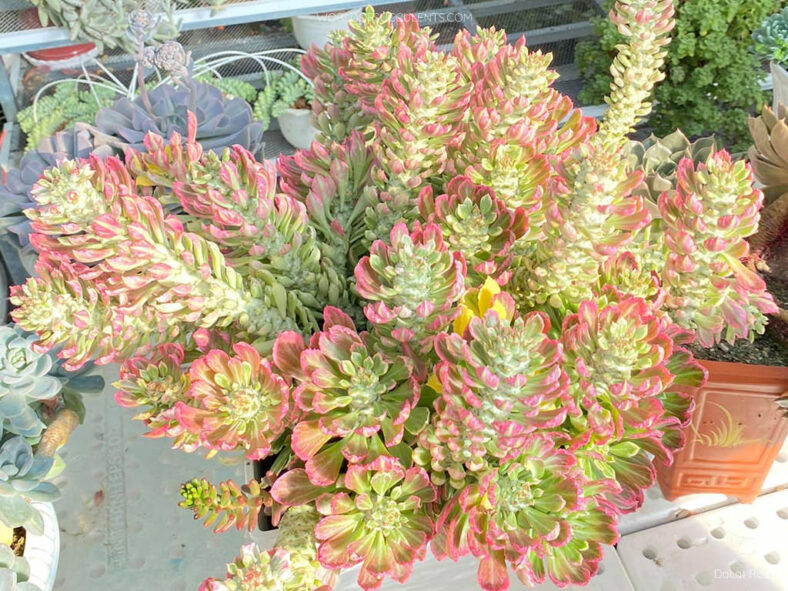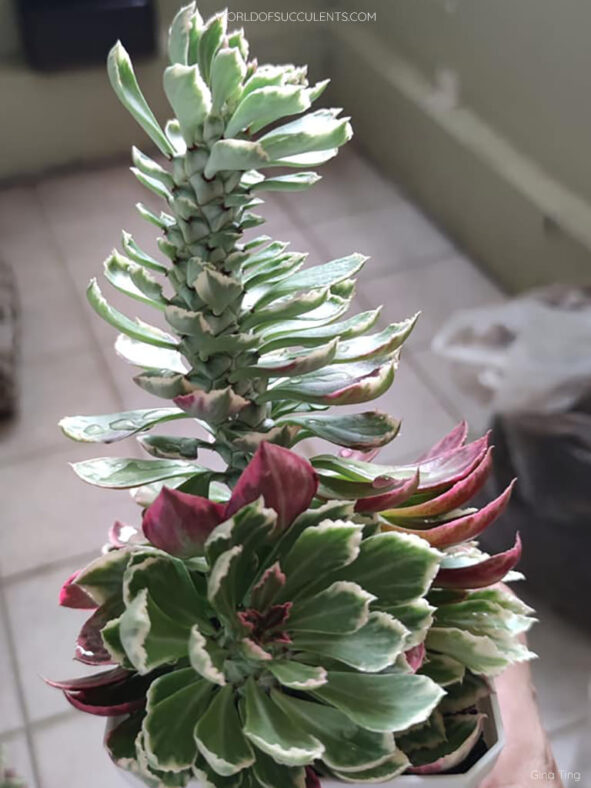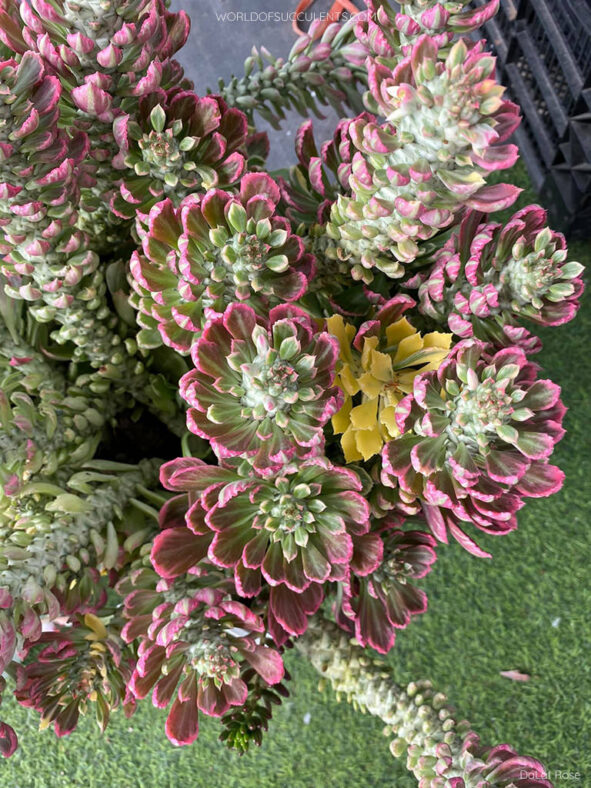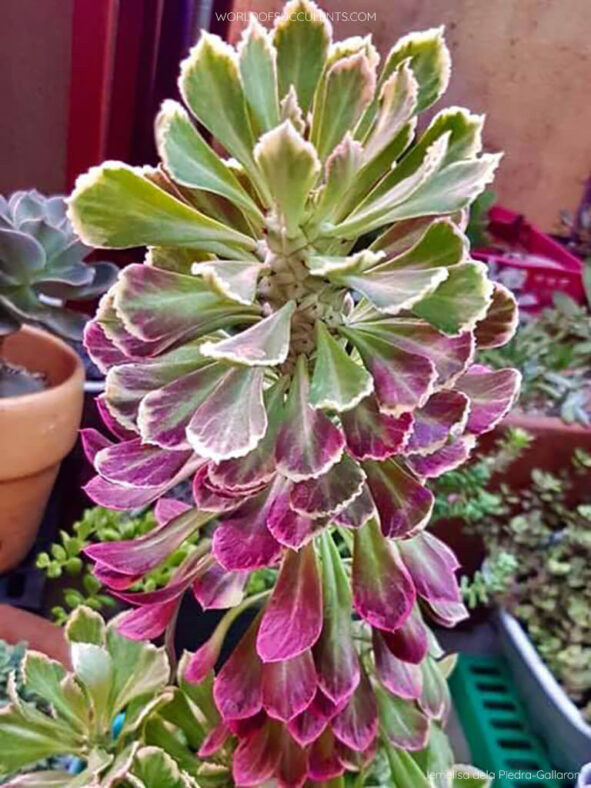Euphorbia succulenta f. variegata is an eye-catching succulent prized for its vibrant colors and unique growth habit. It is more widely cultivated than the typical form of Euphorbia succulenta, and is better known as Monadenium stapelioides f. variegatum.
Scientific Name
Euphorbia succulenta f. variegata
Accepted Scientific Name
Euphorbia succulenta (Schweick.) Bruyns
Synonym(s)
Euphorbia neostapelioides f. variegata, Monadenium stapelioides f. variegatum, Monadenium succulentum f. variegatum
Scientific Classification
Family: Euphorbiaceae
Subfamily: Euphorbioideae
Tribe: Euphorbieae
Subtribe: Euphorbiinae
Genus: Euphorbia
Etymology
The formal epithet "variegata" (pronounced "var-ee-GAY-tuh") means "variegated; having a pattern of different colors or marks."
Origin
Euphorbia succulenta f. variegata is a variegated form of Euphorbia succulenta selected in cultivation for its variegated stems and leaves. Euphorbia succulenta is native to Kenya, Tanzania, and Uganda.
Description
Euphorbia succulenta f. variegata, formerly known as Monadenium stapelioides f. variegatum, is an attractive succulent with numerous nearly pure-white branches adorned with rhomboid, spirally arranged tubercles and variegated leaves. The cylindrical branches primarily grow from the base or sometimes from the top of the stout main stem. Initially upright, the branches become decumbent as they lengthen, reaching up to 12 inches (30 cm) in length and 0.8 inches (2 cm) in diameter.
The lance-shaped leaves are dark green, beautifully striped with cream and pink, and often marbled with purple. They can measure up to 0.5 inches (1.2 cm) in length and 0.25 inches (0.6 cm) in width. The leaves are deciduous and typically found at the tips of the branches.
During the spring and summer, Euphorbia succulenta f. variegata produces clusters of three greenish-white flower heads flushed with pink. Although small, the flower heads become particularly striking when produced in large numbers.

How to Grow and Care for Euphorbia succulenta f. variegata
Light: For optimal growth, your Euphorbia succulenta f. variegata needs plenty of sunlight. During the warmer months, place it near a sunny window or move it to your balcony or garden, gradually increasing sun exposure to avoid sunburn.
Soil: Use a commercial potting mix specifically designed for succulents or create your own well-draining mix.
Temperature: While high summer temperatures are not a problem, low winter temperatures can damage or kill your plant. Euphorbia succulenta f. variegata grows best in USDA Plant Hardiness Zones 10a to 11b, with average minimum winter temperatures ranging from 30°F to 50°F (-1.1°C to 10°C).
Watering: From spring to fall, water the plant when the top inch (2.5 cm) of the soil feels dry. Reduce watering in winter and provide the plant with just enough water to prevent wilting. During the warm season, the evening is the best time of day for watering.
Fertilizing: To ensure the potted plant receives sufficient nutrients, apply a balanced fertilizer in a 10-10-10 NPK formulation, diluted to 1/4 strength weekly during the growing season.
Repotting: Although your Euphorbia succulenta f. variegata does not need to be repotted often, it will benefit from repotting when it outgrows its pot. Repotting is best done in early spring, at the beginning of the growing season. Wear gloves, protective clothing, and appropriate eye protection when handling this plant.
Propagation: This plant is easy to propagate by stem cuttings, which should be taken only during the growing season.
Learn more at How to Grow and Care for Euphorbia.
Toxicity of Euphorbia succulenta f. variegata
Euphorbia succulenta f. variegata produces a poisonous white milky sap that may cause burns or irritation if it comes into contact with the skin or eyes. Therefore, it's best to keep this plant out of reach of children and pets.
Links
- Back to genus Euphorbia
- Succupedia: Browse succulents by Scientific Name, Common Name, Genus, Family, USDA Hardiness Zone, Origin, or cacti by Genus
Photo Gallery
Click on a photo to see a larger version.


